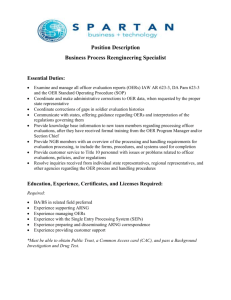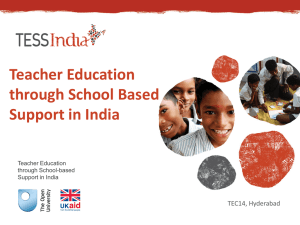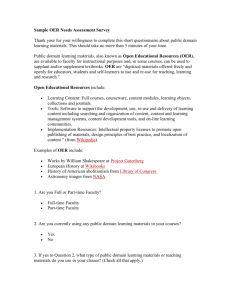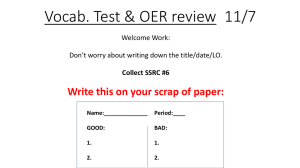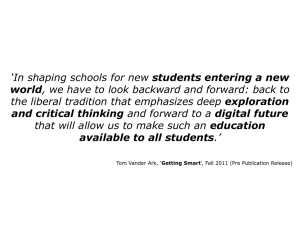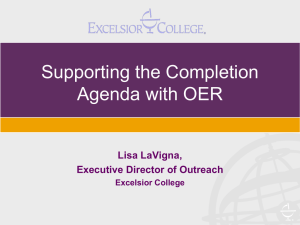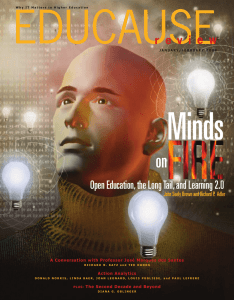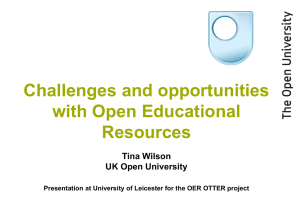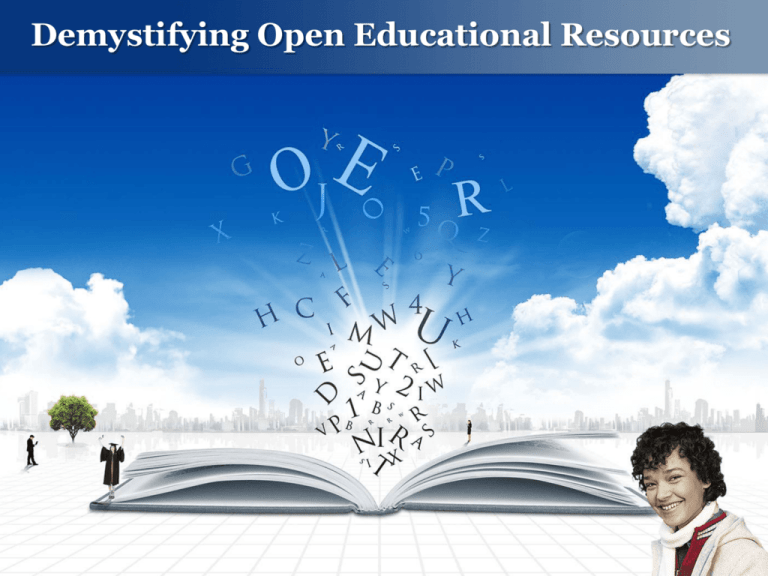
Demystifying Open Educational Resources
Overview
• Introductions
• Overview of the OER landscape
• Ten years later
• How to find and implement OERs
• Key OER initiatives
• Next steps
Definition (OER)
OER are teaching, learning, and research resources that
reside in the public domain or have been released under an
intellectual property license that permits their free use or
re-purposing by others. Open educational resources include
full courses, course materials, modules, textbooks,
streaming videos, tests, software, and any other tools,
materials, or techniques used to support access to
knowledge.
Atkins, Daniel E.; John Seely Brown, Allen L. Hammond (2007-02). A Review of Open
Educational Resources (OER) Movement: Achievements, Challenges, and New
Opportunities.” Menlo Park, CA: The William and Flora Hewlett Foundation. p. 4.
U.S. Department of Education
Open Educational Resources (OER) are an
important element of an infrastructure for
learning.
http://www.ed.gov/technology/netp-2010/open-educational-resources
OERs in the Modern Era
“Open Content”
David Wiley
1998
1998
OpenCourseWare
Consortium
2008
“Open
Educational
Resources”
Coined By
UNESCO
2002
2000
2002
2001
Wikipedia
Creative Commons
MIT OpenCourseWare
Open
University
OpenLearn
2006
2004
2006
Open Course Library
MITx
2011
2008
2010
2012
2007
Cape Town
Declaration
2000s
William and Flora Hewlett
Foundation Support
2009
Open High School of Utah
American Graduation Initiative
& $2B in funding
University of the People
Source: WikiEducator. (2012). OER Timeline. http://wikieducator.org/OER_timeline
Ten Years Later
Why OERs
have not
noticeably
Affected
Higher
Education
Gerd Kortemeyer
February 26, 2013
Educause Review
www.educause.edu
and Why
We
Should
Care
Why Open Education Matters
Director & author: Nadia Mireles http://nadiamireles.blogspot.com/
Producers: http://funktionell.com.mx
http://whyopenedmatters.org
This video is under CC by 3.0 license
www.youtube.com/watch?v=dTNnxPcY49Q
http://creativecommons.org/licenses/by/3.0/
The OER Landscape
Open Educational Resources
Do you…
• Talk about your courses
with your peers?
• Borrow course
materials, teaching
techniques, sources?
• Share your materials?
OER is all of these things!
• At it’s heart, OER is about
doing these sorts of things!
• And, it’s about encouraging
sharing of materials and
practices
• and clearly communicating
what you’re allowing
others to do with your
materials
What are you allowed to do?
• Instead of “All Rights Reserved”
• Can someone else use your materials?
• Can someone build upon or modify your materials?
• Can they use those materials commercially?
• Do they have to share any materials they develop the same
way you shared your materials?
• Do these sound familiar?
• These are the basics of Creative Commons Licenses
• A “standard” way providing permissions to your work
Community College Consortium for
Open Educational Resources
www.oerconsortium.org
Resources for
Community Colleges
Open Course Library
www.opencourselibrary.org
MERLOT
www.merlot.org
Saylor Foundation
www.saylor.org
Kaleidoscope Project
www.project-kaleidoscope.org
20 Million Minds
http://www.20mm.org/
MITOpenCourseware
http://ocw.mit.edu/index.htm
OpenLearn
http://www.open.edu/openlearn/
http://www.nationalstem.org/
What is the NSC?
A consortium of ten leading community colleges, in
nine states, organized to:
Develop nationally portable, certificate-level programs in
Science, Technology, Engineering, and Mathematics (STEM)
Build a national model for multi-college cooperation in the
design and delivery of high-quality occupational programs
responsive to labor-market needs
NSC Industries
Composite Materials
Cyber Technology
Electric Vehicle Development and Repair
Environmental Technology
Mechatronics
NATIONAL STEM CONSORTIUM STEM BRIDGE
STEM READINESS: 45-hour online course co-developed with Carnegie Mellon
Open Learning Initiative (OLI) and CAST designed to quickly refresh “rusty” skills
for TAA and dislocated workers entering certificates directly. Closely working
with industry partners to develop real-life workplace scenarios.
Math – 15 Hours
Critical Thinking and Workplace Communication – 15 hours
Professional Skills – 15 Hours
FAST TRACKS: Accelerated 8-10 week “on-ramp” designed to quickly build key
skills for lower level learners immediately prior to entry in the Credit Certificate
programs. This part will be backward designed from STEM Bridge and will be
offered in intensive format 4-5 days per week.
To access the STEM Bridge
course, visit Carnegie Mellon
University, Open Learning
Initiative:
http://oli.cmu.edu/learn-with-oli/
see-our-free-open-courses/
Open Learning: Bridge to Success
Bridge to Success is made possible through a Next Generation Learning Challenge grant awarded to Anne Arundel
Community College, the Open University (UK), University of Maryland University College (UMUC) and Massachusetts
Institution of Technology (MIT). NGLC is led by EDUCAUSE in partnership with The League for Innovation in the Community
College, the International Association of K-12 Online Learning and the Council of Chief State School Officers. The Bill and
Melinda Gates Foundation and the William and Flora Hewlett Foundation helped design the Next Generation Learning
Challenges and fund the initiative.
Bridge to Success Courses and Resources
• Courses
• Learning to Learn
• Succeed with Math
• Resources
• Instructor’s Toolkit
• Student’s Toolkit
• Math Anxiety Webshop
Learning to Learn
Succeed with Math
labspace.open.ac.uk/b2s
For more information about
Bridge to Success, visit:
http://bridge2success.aacc.edu
Next Steps…
For more information:
Jean M. Runyon, Dean
Learning Advancement and the Virtual Campus
Anne Arundel Community College
410-777-1249
jmrunyon@aacc.edu

